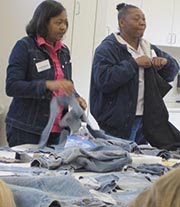Through the years, a dear friend has filled my home with exquisite stitch wizardry in the form of clothing, decorative items, quilted wall hangings, and a beautiful quilted bedspread. Nevertheless, until last November, I was completely ignorant about the art—or is it the craft?—of quilting.
In October, I attended a class called Design, Aesthetics, and Application presented by the Osher Lifelong Learning Institute. The class met at the Boise Art Museum (BAM) and was taught by Terra Feast, BAM’s associate curator of education. One segment of the class focused on the debate over art versus craft. The featured Survey of Gee’s Bend Quilts provided provocative class discussions. We discovered how specific patterns and designs have influenced quilting through the ages. We also learned about the extraordinary geography and socio-political history of Gee’s Bend, Alabama.
Then we beheld the quilts! The sampling of quilts ranged in vintage from 1940 to 2007. Born of a poverty that I can barely fathom, the quilts leaped off the gallery walls with joy, pride, and family reverence. Prints made by quilters Mary Lee and Louisiana Bendolph at the Berkeley Paulsen Press sprouted among the tactile cloth pieces that lured a prohibited touch. Printmaking is an entirely new skill to the Gee’s Bend community. An hour-long, looping video explained the history of Gee’s Bend, its quilting geniuses, and their recent introduction into the broader art world.
 Utterly transported by the exquisite beauty of Gee’s Bend art, — or is it craft? — I attended a quilting demo and discussion with visiting artists Louisiana Bendolph and China Pettway. Matt Arnett, the women’s traveling companion and Director of Exhibitions for Tinwood Media. China burst into a prayer of thanks to the Lord, punctuated by an amazing a cappella spiritual, which erupted like magma from the center of the Earth. Her body is a vessel for heavenly praise.
Utterly transported by the exquisite beauty of Gee’s Bend art, — or is it craft? — I attended a quilting demo and discussion with visiting artists Louisiana Bendolph and China Pettway. Matt Arnett, the women’s traveling companion and Director of Exhibitions for Tinwood Media. China burst into a prayer of thanks to the Lord, punctuated by an amazing a cappella spiritual, which erupted like magma from the center of the Earth. Her body is a vessel for heavenly praise.The isolation of Gee’s Bend, Alabama, a pocket community enclosed on three sides by the Alabama River, might replicate that of Yellow Pine, here in Idaho. The quilters of Gee’s Bend may occasionally copy or borrow designs and themes from each other, but they were never exposed to “serious art” like that of famed artists Jackson Pollack and Mark Rothko, to whom their works are often compared.
Is it an accident that such highly esteemed designs emerged from an artistic void? Can Gee’s Bend quilts be denied classification as high art, simply because they were conceived primarily for utility? For me, the Gee’s Bend quilting tradition defies the elitist separation of art and craft. Sue Willie Seltzer’s “Housetop” quilt—a nine-block “Half-Log Cabin” variation from the 1950’s— exhibits an astonishing human drive to arrange line, shape, form, color, space, texture, and value, to create an aesthetic object that is as astonishing on a gallery wall as it is a useful blanket bundling a handful of children on a winter night. In this case, craft is art. The J. R. Simplot Company Foundation deserves kudos for sponsoring this exhibit, which will remain at BAM until March 14.



Blushing to see my praises sung on your blog. At the risk of taking myself too seriously, I've decided to describe myself as an artist; if others want to use the term "craft", that's okay, too.Thanks, sweetie!Cris
LikeLike
YES!
LikeLike
PS to Cris, I'm tremendously happy that you approve. I consider your opinion of the highest order.
LikeLike